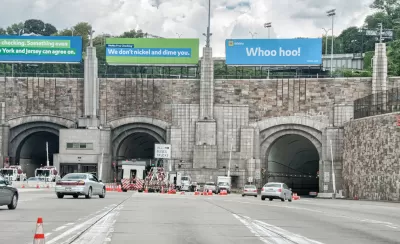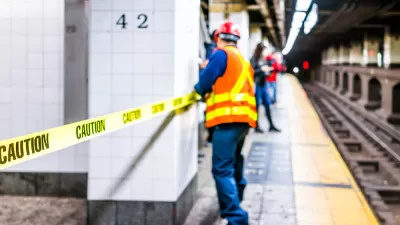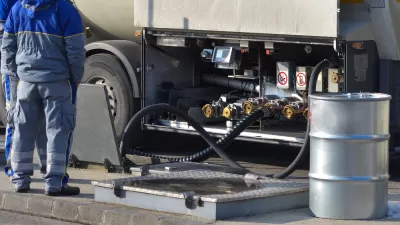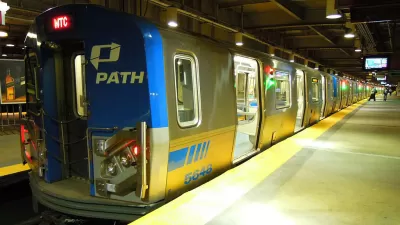In advance of unveiling his infrastructure plan on Tuesday night, President Trump pointed to the hazards posed by "missing tiles" in two New York City tunnels and wondered aloud how many had fallen on motorists. Answer: none.

President Trump is known to veer off script, which can be troublesome even if it often goes over well with his supporters. In his remarks to the National Governors Association's winter meeting in the White House on Monday, he told them to expect something 'big' from him on infrastructure during his address to a joint session of Congress on Tuesday.
As an example, he cited two tunnels that serve Manhattan that appear, to him, to not only be in a state of disrepair, but to pose serious safety hazards.
Our tunnels -- I mean, we have tunnels in New York where the tiles are on the ceiling, and you see many tiles missing. And you wonder, you know, you're driving at 40 miles an hour, 50 miles an hour through a tunnel.
Take a look at the Lincoln Tunnel and the Queens Midtown Tunnel,, and you're driving, and you see all this loose material that's heavy....And I say to myself -- every time I drive through, I say, I wonder how many people are hurt or injured when they are driving at 40, 50 miles an hour through a tunnel, and the tile falls off.
Trump can't be blamed for thinking of falling tiles—it's not unreasonable. The CBS News show, 60 Minutes, did a memorable infrastructure report in November 2014 that pointed to Pittsburgh's decaying Greenfield Bridge. The temporary solution to deal with falling debris was to place a bridge under the bridge just to protect traffic below from being hit by falling debris. But why not have his staff research the tunnels' 'falling tiles' before citing them?
Vincent Barone and Emily Ngo, reporters for amNewYork, investigated. First, the Queens Midtown Tunnel:
Not a single person has been injured by any falling tiles because no tiles are falling — they are being replaced by workers as part of an infrastructure project to repair the tunnel from Hurricane Sandy damage,” said Beth DeFalco, an MTA [Metropolitan Transportation Authority] spokeswoman, in an email.
As for the Lincoln Tunnel, the result was the same:
A spokesman for the Port Authority, which operates the Lincoln Tunnel, said in a statement that “the tile structures in the various Lincoln Tunnel tubes are intact, regularly inspected and pose no danger to the public. In the last 12 months there have been no reported incidents involving falling tiles.
There is no need to point to false examples of infrastructure disrepair when thousands of American bridges are either structurally deficient and/or functionally obsolete.
Eugene Mulero reports for Transport Topics that the governors' association responded to Trump's comments on infrastructure, specifically, how to finance the infrastructure investment.
“Public-private partnerships are a great tool, and I think they have to be embraced,” Gov. John Hickenlooper (D-Colo.) said at the association’s closing press conference. “There’s got to be additional revenues, and states will have to come up with additional resources. The federal government will have to come up with additional resources.”
Hat tips to Brianna Gurciullo, POLITICO Morning Transportation, and MTC-ABAG Library.
FULL STORY: Trump fears tiles fall from NYC tunnels, pledges ‘big’ infrastructure spending

Trump Administration Could Effectively End Housing Voucher Program
Federal officials are eyeing major cuts to the Section 8 program that helps millions of low-income households pay rent.

Planetizen Federal Action Tracker
A weekly monitor of how Trump’s orders and actions are impacting planners and planning in America.

Ken Jennings Launches Transit Web Series
The Jeopardy champ wants you to ride public transit.

Tackling Soil Contamination With Nature-Based Solutions
Los Angeles County residents and experts are turning to nature-based methods like bioremediation to address long-standing and fire-exacerbated soil contamination without resorting to costly and disruptive removal.

Rebuilding Smarter: How LA County Is Guiding Fire-Ravaged Communities Toward Resilience
Los Angeles County is leading a coordinated effort to help fire-impacted communities rebuild with resilience by providing recovery resources, promoting fire-wise design, and aligning reconstruction with broader sustainability and climate goals.

When Borders Blur: Regional Collaboration in Action
As regional challenges outgrow city boundaries, “When Borders Blur” explores how cross-jurisdictional collaboration can drive smarter, more resilient urban planning, sharing real-world lessons from thriving partnerships across North America.
Urban Design for Planners 1: Software Tools
This six-course series explores essential urban design concepts using open source software and equips planners with the tools they need to participate fully in the urban design process.
Planning for Universal Design
Learn the tools for implementing Universal Design in planning regulations.
Ada County Highway District
Clanton & Associates, Inc.
Jessamine County Fiscal Court
Institute for Housing and Urban Development Studies (IHS)
City of Grandview
Harvard GSD Executive Education
Toledo-Lucas County Plan Commissions
Salt Lake City
NYU Wagner Graduate School of Public Service





























